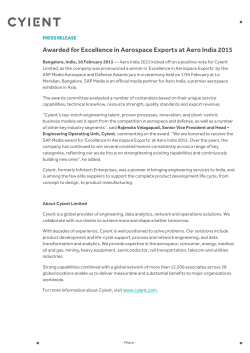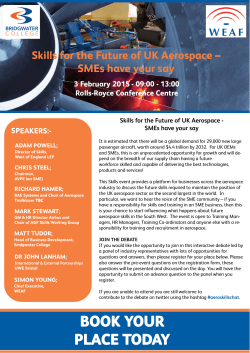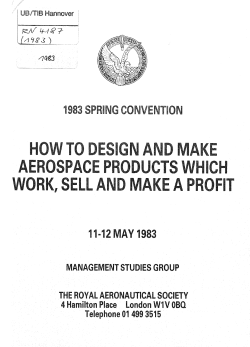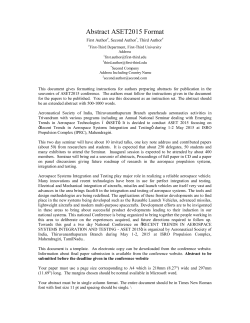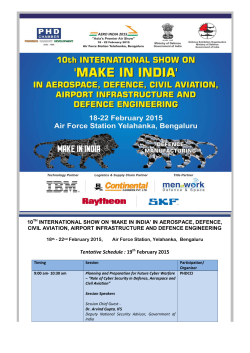
spatio-temporal coherent flow structure evolution of znmf jet
European Drag Reduction and Flow Control Meeting – EDRFCM 2015 March 23–26, 2015, Cambridge, UK SPATIO-TEMPORAL COHERENT FLOW STRUCTURE EVOLUTION OF ZNMF JET CONTROLLED NACA 0015 AIRFOIL FLOW J. Soria Laboratory for Turbulence Research in Aerospace and Combustion (LTRAC) Department of Mechanical and Aerospace Engineering Monash University, Melbourne, VIC 3800, AU and Department of Aeronautical Engineering King Abdulaziz University Jeddah, Kingdom of Saudi Arabia C. Atkinson Laboratory for Turbulence Research in Aerospace and Combustion (LTRAC) Department of Mechanical and Aerospace Engineering Monash University, Melbourne, VIC 3800, AU N. Buchman Laboratory for Turbulence Research in Aerospace and Combustion (LTRAC) Department of Mechanical and Aerospace Engineering Monash University, Melbourne, VIC 3800, AU V. Kitsios Laboratory for Turbulence Research in Aerospace and Combustion (LTRAC) Department of Mechanical and Aerospace Engineering Monash University, Melbourne, VIC 3800, AU ABSTRACT expressed as: fwake ∝ One of the primary aims of flow separation control is to prevent boundary layer separation and as such extend the effective operational range of engineering devices such as diffusers, compressors, turbines and airfoils. Separation flow control can be implemented by either the addition of fixed geometric features such as vortex generators or flaps, (referred to as passive control), or via the addition of kinetic energy in the form of small-scale or large-scale perturbations in order to modify the flow (i.e. active control [2]). Active control can take various forms, such as steady or oscillatory blowing and/or suction, vibrating surfaces or acoustic excitation (see [3]) and unlike passive methods can be deactivated or adjusted to cater to a wider range of operating conditions. U∞ . Lwake (1) As the AoA increases, flow separation occurs, introducing frequencies associated with the separated shear layer whose frequency fSL is proportional to the shear layer advection velocity USL and its momentum thickness θSL [4], such that: fSL ∝ USL . θSL (2) For some airfoils at moderate AoA this separation may occur near the leading edge, allowing the flow to reattach to the airfoil further downstream and thereby forming a transient separation bubble with an associated frequency fsep , proportional to the time-average separation length Lsep [8], such that: U∞ . (3) fsep ∝ Lsep For the case of flow over airfoils, active flow control via periodic excitation has been shown to delay separation and hence, increase lift at angles of attack (AoA) beyond the natural stall angle [11]. Time-dependent forcing, such as that produced by pulsating jets, has been shown to require of the order of 80% less momentum than steady blowing or suction for the same lift coefficient [10]. This difference is thought to be associated with the excitation of frequency (i.e. temporal) characteristics, which are related to characteristic time-scales of the flow and hence depend on the AoA. For most airfoils at low AoA the flow will be completely attached such that the dominant frequency fwake is associated with the time-scale of the wake of the airfoil and is proportional to the free-stream velocity U∞ and the length-scale of the wake Lwake [9], which can be At high AoA, where separation control is of most interest, the flow usually will not reattach and the dominant or natural frequencies will be fwake and fSL . The results presented in this paper are concerned with the flow configuration used by [11], in which ZNMF jet forcing was applied at the leading edge of a NACA-0015 airfoil at Re = 3 × 104 . In this case laminar separation occurs in the vicinity of the leading edge for the unforced case. From a series of lift force measurements over a range of AoA, forcing frequencies and momentum blowing coefficients, [11] observed a maximum lift enhancement of 45% at AoA α = 18◦ when 1 excitation was applied at optimal frequencies of f + = 0.65 and 1.3. Dye flow visualisations and planar PIV measurements were performed which show the dramatic reduction of the separated flow region when this forcing was applied (Figure 1). However these measurements were unable to capture the dynamics and frequencies associated with these flow structures in either the excited or natural case. of Re = 3 × 104 , defined as: U∞ c (4) ν The ZNMF jet forcing is applied along the entire span of the airfoil and normal to the leading edge, via a rectangular slot of height h = 0.15 ± 0.05 mm and length l = 460 mm. The jet is driven by pressure oscillations that are supplied to a cylindrical cavity with a diameter of 5 mm, located behind the slot. Unlike experiments in air, the high viscosity and incompressible behaviour of water means that the optimal forcing frequency (f = 3.3 Hz) can be achieved using a stepper motor driven piston of diameter Dp = 20 mm coupled with a Scotch-Yoke mechanism, as shown in Figure 2. This external mechanism allows the use of a relatively thin airfoil with a low blockage ratio, while also enabling easy adjustment of the forcing frequency f and amplitude a ˆ by varying the motor speed and Scotch-Yoke crank length, respectively. Re = Piston Scotch-Yoke Airfoil (a) Jet Airfoil U x U y Light sheet Tunnel walls High energy mirror Light sheet z Jet Laser sheet optics x Tunnel floor Camera Nd:YLF Laser Figure 2: Schematic of the experimental setup in the horizontal water tunnel. (b) The flow features and frequencies associated with both the uncontrolled baseline case and the open-loop leading edge ZNMF control case at the optimum frequency of [11] are studied based on the HR-PIV measurements. This data also allowed the recovery of the Koopman modes associated with the separated airfoil flow [5] which are also discussed. Figure 1: Dye flow visualisation adapted from [11] of a NACA0015 airfoil, Re = 3 × 104 , α = 18o : (a) unforced case; (b) ZNMF jet forcing at the leading edge, f + = 1.3, cµ = 0.0014. . Recently [6] studied the same configuration using largeeddy simulation (LES) to investigate the frequencies and stability modes present in the unforced base flow and to improve understanding of the separated flow and the reason for the optimal forcing frequency. Results identified both a shear layer instability at the leading edge and bluff body shedding with the most unstable mode corresponding to a frequency on the order of the first sub-harmonic of the leading edge shear layer frequency fSL /2. REFERENCES [1] N A Buchmann, N A Buchmann, C Atkinson, C Atkinson, J Soria, and J Soria. Experiments in Fluids, 54(3):1485, 2013. [2] J. Donovan, L. Kral, and A. Cary. In AIAA Paper 98-0329, 1998. [3] D. Greenblatt and I. J. Wygnanski. Progress in Aerospace Sciences, 36:487–545, 2000. [4] C. Ho and P. Huerre. Annu. Rev. Fluid Mech., 16:365–424, 1984. [5] V Kitsios, N A Buchmann, C Atkinson, J S Frederiksen, and J Soria. In Instability and Control of Massively Separated Flows, pages 39–44. Springer International Publishing, January 2015. [6] V. Kitsios, L. Cordier, J.-P. Bonnet, A. Ooi, and J. Soria. J. Fluid Mech., 683:395–416, 2011. [7] J. Kostas, J. Soria, and M.S. Chong. Experiments in Fluids, 33(6):838 – 53, 2002. [8] R. Mittal, Kotapati, R. B., and L. N. Cattafesta. In 43rd AIAA Aerospace Sciences Meeting and Exhibit. Reno, Nevada, 2005. [9] A. Roshko. NACA Tech. Rep. 1191, 1954. [10] A. Seifert, T. Bachar, D. Koss, M. Shepshelovich, and I. Wygnanski. AIAA Journal, 31(11):2052–2060, 1993. [11] A. Tuck and J. Soria. Aircraft Engineering and Aerospace Technology, 80(2):175–180, 2008. This paper presents fully time-resolved measurements of the flow acquired using HR-PIV to provide the spatiotemporal 2C-2D velocity vector field over the NACA-0015 airfoil [1] in the same experimental configuration and facility as [11]. The experiments are conducted in a horizontal recirculating water tunnel, which consists of 5 working sections of 1.1 m length and 500 mm × 500 mm cross-section. An extensive characterisation of this facility is given in [7]. A Perspex NACA-0015 airfoil with a chord length c = 100 and a span of 510 mm is mounted vertically in the second working section such that the top of the airfoil protrudes above the free-surface at all times. A gap of approximately 2 mm is left between the airfoil and the floor to enable adjustment of the AoA without damaging the tunnel floor. The free-stream turbulence intensity, assessed by PIV is less than 0.75%. The tunnel is operated at a freestream velocity of U∞ = 260 mm/s at 25.5◦ C, corresponding to a chord-based Reynolds number 2
© Copyright 2025


